Antibody data
- Antibody Data
- Antigen structure
- References [1]
- Comments [0]
- Validations
- Immunohistochemistry [4]
- Other assay [1]
Submit
Validation data
Reference
Comment
Report error
- Product number
- PA5-58813 - Provider product page

- Provider
- Invitrogen Antibodies
- Product name
- NCKAP1L Polyclonal Antibody
- Antibody type
- Polyclonal
- Antigen
- Recombinant protein fragment
- Description
- Immunogen sequence: VLIRMYNIKK TCSDPKSKPP FLLEKSMEPS LKYINKKFPN IDVRNSTQHL GPVHREKAEI IRFLTNYYQS FVD Highest antigen sequence identity to the following orthologs: Mouse - 96%, Rat - 97%.
- Reactivity
- Human
- Host
- Rabbit
- Isotype
- IgG
- Vial size
- 100 μL
- Concentration
- 0.5 mg/mL
- Storage
- Store at 4°C short term. For long term storage, store at -20°C, avoiding freeze/thaw cycles.
Submitted references NCKAP1L defects lead to a novel syndrome combining immunodeficiency, lymphoproliferation, and hyperinflammation.
Castro CN, Rosenzwajg M, Carapito R, Shahrooei M, Konantz M, Khan A, Miao Z, Groß M, Tranchant T, Radosavljevic M, Paul N, Stemmelen T, Pitoiset F, Hirschler A, Nespola B, Molitor A, Rolli V, Pichot A, Faletti LE, Rinaldi B, Friant S, Mednikov M, Karauzum H, Aman MJ, Carapito C, Lengerke C, Ziaee V, Eyaid W, Ehl S, Alroqi F, Parvaneh N, Bahram S
The Journal of experimental medicine 2020 Dec 7;217(12)
The Journal of experimental medicine 2020 Dec 7;217(12)
No comments: Submit comment
Supportive validation
- Submitted by
- Invitrogen Antibodies (provider)
- Main image
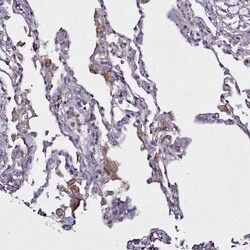
- Experimental details
- Immunohistochemical analysis of NCKAP1L in human lung using NCKAP1L Polyclonal Antibody (Product # PA5-58813) shows moderate cytoplasmic positivity in macrophages.
- Submitted by
- Invitrogen Antibodies (provider)
- Main image
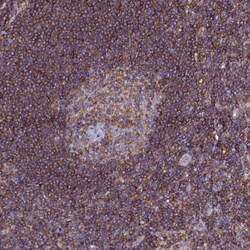
- Experimental details
- Immunohistochemical analysis of NCKAP1L in human lymph node using NCKAP1L Polyclonal Antibody (Product # PA5-58813) shows strong cytoplasmic positivity in non-germinal center cells.
- Submitted by
- Invitrogen Antibodies (provider)
- Main image
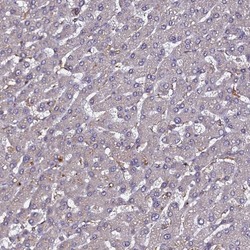
- Experimental details
- Immunohistochemical analysis of NCKAP1L in human liver using NCKAP1L Polyclonal Antibody (Product # PA5-58813) shows low positivity in hepatocytes as expected.
- Submitted by
- Invitrogen Antibodies (provider)
- Main image
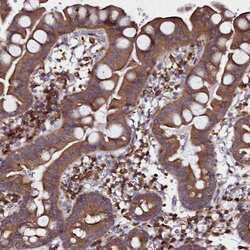
- Experimental details
- Immunohistochemical analysis of NCKAP1L in human small intestine using NCKAP1L Polyclonal Antibody (Product # PA5-58813) shows strong cytoplasmic positivity in lymphoid cells.
Supportive validation
- Submitted by
- Invitrogen Antibodies (provider)
- Main image
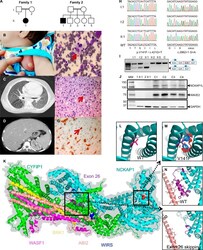
- Experimental details
- Figure 1. Homozygous NCKAP1L mutations identified in the two families. (A) Pedigrees of affected consanguineous families of Iranian (family 1) and Saudi Arabian (family 2) origins. Generations are designated by Roman and subjects by Arabic numerals. Double lines connecting parents indicate consanguinity. Squares, male subjects; circles, female subjects; filled (black) symbols indicate patients, while unfilled (white) symbols indicate unaffected family members. All family members in family 1 and all in family 2, with the exception of II.3 and II.4, were subjected to whole-exome sequencing. (B) Photograph of axillary lymphadenitis in patient 1. (C-G) In patient 2, a thoracoabdominal computed tomography scan showed right lung focal oligemia and brocheactesis (C) and massive hepatosplenomegaly (D). In the same patient, bone marrow aspirates showed hemophagocytosis (E), whereas liver staining with hematoxylin and eosin (F) or CD68 (G) showed sinusoidal dilatation with hemophagocytic histiocytosis. (H) Sanger traces of the disease-associated NCKAP1L mutations confirming autosomal recessive inheritance. Electropherograms show single base pair substitutions c.421G>T of NCKAP1L (NM_005337) causing V141F missense in family 1 (left panel) and a single base pair substitution c.2821+1 G>A disrupting the donor splice site of NCKAP1L exon 26 in family 2. (I) RT-PCR in PBMCs in family 2 shows homozygous skipping of exon 26 in patient II:1. (J) Western blot analysis of NCKAP1L complex protein
 Explore
Explore Validate
Validate Learn
Learn Western blot
Western blot Immunohistochemistry
Immunohistochemistry